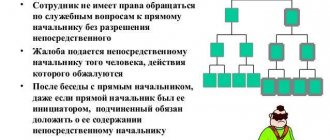Legislative regulation of the issue
The latest regulatory act in this area is SanPiN 2.2.4.3359-16 “Sanitary and epidemiological requirements for physical factors in the workplace” (approved by Resolution of the Chief State Sanitary Doctor of the Russian Federation dated June 21, 2021 No. 81).
The purpose of the rules is to prevent diseases or deviations in the health status of employees , the root cause of which is the unfavorable environment of the office premises.
The conditions for office employees have also been standardized, whose work, taking into account the total energy consumption of the body due to the nature of the activity (up to 139 W), is classified as work category Ia (Appendix 1 to SanPiN, Table A 1.1).
Directly devoted to the temperature regime in workplaces, SanPiN 2.2.4.548-96 “Hygienic requirements for the microclimate of industrial premises” (approved by Resolution of the State Committee for Sanitary and Epidemiological Supervision of the Russian Federation dated October 1, 1996 No. 21).
Permissible air temperature in the workplace
SanPiN 2.2.4.548-96 standards provide for small deviations from the optimal temperature in the workplace. Changes in these values up to 4–6 °C are possible.
If working conditions suggest a deviation from the optimal values and permissible temperature standards in the workplace, employees have legal grounds to reduce their working hours. The higher the deviation level, the shorter the working day. For example, at a workplace temperature of about 13 °C, the permissible work duration for office employees is no more than an hour.
Rospotrebnadzor spoke about how to reduce the length of the working day in the heat.
Attention! Recommendation from ConsultantPlus: To formalize a shortened working day in hot weather, we recommend recording the elevated temperature in a protocol, and formalizing the shortening of the working day due to hot weather by order. What to reflect in these documents, see K+.
As can be seen from the table, the higher the temperature, the less the employee should work. What should the employer do in this case? How to pay employees? If temperature standards in the workplace are exceeded, the employer has the right to declare downtime. Downtime is paid in the amount of 2/3 of the salary (tariff rate), calculated in proportion to downtime (Article 157 of the Labor Code of the Russian Federation).
ATTENTION! According to SanPin standards, if the temperature in the workplace exceeds 32.5 degrees, there is no time spent at the workplace. In this case, the employer must declare the day a day off and pay for downtime in accordance with Art. 157 Labor Code of the Russian Federation.
By agreement with employees, the employer has the right to release employees on short-term paid vacations outside the vacation schedule.
Important to consider! Recommendation from ConsultantPlus: The procedure for paying for the time by which the working day is shortened in the heat is not established by law. We offer you the following methods, and you choose the one that suits you... (for more details, see K+).
You can read about how to record working time in the article “Working time sheet on form T-12 - form” .
Seasonal sanitary standards
There is no division into summer, winter and off-season spring and autumn in sanitary norms and rules.
Climatic periods are defined as:
- cold , when the average daily outside air temperature is +10°C and below;
- warm - the average is above +10°C.
The optimal recommended microclimate for offices with an 8-hour working day is as follows:
- cold period of the year: +22-24оС at surface temperature +21-25оС;
- warm period of the year: +23-25оС at surface temperature +22-26оС.
For employees who spend their entire working time indoors, it is permissible to deviate from the norm:
- temperature deviation by 1-2°C;
- temperature fluctuations during the working day – no more than 3-4°C.
Thus, if the maximum temperature in the office workplace is +28 degrees C (minimum +20 C) according to SanPiN, there is no reason to reduce working hours, but if the air temperature in the office space is higher or lower than the standard, for example, it exceeds 30 degrees, then changes should be made to the work schedule.
Temperature standards in the workplace
Average optimal temperature conditions depend on operating conditions and time of year. The less energy is consumed during work, the higher this indicator should be:
- for office workers: in the warm season - 23–25 °C, in the cold season - 22–24 °C;
- for workers with light physical activity: in summer - 22–24 °C, in winter - 21–23 °C;
- for persons whose work involves walking and light physical activity: in summer - 20–22 °C, in winter - 19–21 °C;
- for employees whose work requires increased physical activity: in summer - 19–21 °C, in winter - 17–19 °C;
- for workers with high physical activity: in summer - 18–20 °C, in winter - 16–18 °C.
Why you need a description of working conditions in the workplace, find out here.
Temperature and working time table
| Air temperature at the workplace, °C (for the cold season) | Time spent at work, hour. (no more) | Air temperature in the workplace, °C (for the warm season) | Time spent at work, hour. (no more) |
| 6 | 0 | 33 | 0 |
| 7 | 0 | 32,5 | 1 |
| 8 | 0 | 32 | 2 |
| 9 | 0 | 31,5 | 2,5 |
| 10 | 0 | 31 | 3 |
| 11 | 0 | 30,5 | 4 |
| 12 | 0 | 30 | 5 |
| 13 | 1 | 29,5 | 5,5 |
| 14 | 2 | 29 | 6 |
| 15 | 3 | 28,5 | 7 |
| 16 | 4 | 28 | 8 |
| 17 | 5 | 27,5 | 8 |
| 18 | 6 | 27 | 8 |
| 19 | 7 | 26,5 | 8 |
| 20 | 8 | 26 | 8 |
Seasonal requirements for office temperature
In cold and warm seasons, ensuring optimal temperature is achieved in different ways. Accordingly, the requirements for the microclimate will differ, as well as the measures provided for by SanPiN in the event of the impossibility of ensuring the temperature regime or its serious violations.
So that it doesn't get too hot
Prolonged exposure to elevated temperatures is particularly detrimental to the performance and health of workers. In a closed work space, it can be aggravated by large crowds of people, the presence of working office equipment, and compliance with a special dress code.
In this regard, the optimal temperature values and the permissible maximum during the hot period of the year are legally established. For office workers they are 23-25°C with a relative humidity of 40-60%. Temperature increases up to 28°C are allowed.
Exceeding summer temperatures in the office
If the thermometer inside the office deviates from the optimum by more than 2°C, it becomes much more difficult to work. The employer will have to supply air conditioning for employees and ensure its normal operation and timely maintenance.
If for some reason this is not done, the employee should not meekly endure the sweltering heat, while also trying to meet professional requirements. Sanitary standards allow workers to rightfully shorten the standard eight-hour working day, for which the temperature requirements are designed:
- 29°C allows you to work 6 hours instead of 8;
- 30°C allows for a two-hour contraction;
- each subsequent degree exceeding the norm reduces the working time requirements by another 1 hour;
- if the thermometer reaches 32.5°C, you don’t have to stay at work for more than 1 hour.
Many employees note the negative impact of air conditioning, comparable in harm to heat and stuffiness. The same requirements of SanPiN, along with temperature and humidity, limit the speed of air movement in the room, which should not go beyond the range of 0.1-0.3 m/s. It follows that the employee should not be under the blowing air conditioner.
Employer's liability for violations
Part 2 of Article 22 of the Labor Code of the Russian Federation obliges the employer to ensure satisfactory working conditions. Failure to comply with regulatory labor safety requirements has signs of an administrative offense under Article 5.27.1 of the Code of Administrative Offenses of the Russian Federation.
Part 1 of Article 5.27.1 of the Code of Administrative Offenses provides for:
- for officials - a warning or a fine from 2 thousand to 5 thousand rubles;
- for individual entrepreneurs - a fine from 2 thousand to 5 thousand rubles;
- for legal entities - a fine of 50 thousand to 80 thousand rubles.
For repeated commission of a similar offense, Part 5 of Article 5.27.1 of the Code of Administrative Offenses provides for enhanced punishment:
- for officials - a fine of 30 thousand to 40 thousand rubles or disqualification for a period of one to three years;
- for individual entrepreneurs - a fine in the amount of 30 thousand to 40 thousand rubles or administrative suspension of activities for up to 90 days;
- for institutions and organizations - a fine of 100 thousand to 200 thousand rubles or administrative suspension of activities for up to 90 days.
In addition, liability for violation of sanitary rules and hygienic standards is provided for in Article 6.3 of the Code of Administrative Offenses of the Russian Federation:
- for individual entrepreneurs – a fine of 500 to 1000 rubles or suspension of activities for up to 90 days;
- for legal entities - penalties in the amount of 10 thousand to 25 thousand rubles or also administrative suspension of activities for up to ninety days.
If it is impossible to solve the problem of optimal comfortable temperature conditions according to SNiP in offices in a centralized way, workers should be provided with heaters, split systems, air conditioners and other local technical means.
If there is no control over the microclimate in office premises by officials responsible for labor protection in the organization, the deviation from the established standards should be reported to the manager , preferably in writing, keeping a copy of the appeal.
Results
Ensuring the required temperature level at employee workplaces is the responsibility of the employer. The rights of workers to comfortable working conditions, including maintaining the proper level of temperature in the workplace, are established by the provisions of the Labor Code of the Russian Federation.
To avoid conflict situations, employers are recommended to equip workplaces with air conditioning or heating. Failure to comply with these conditions may result in fines or suspension of the entity's activities.
Sources: Labor Code of the Russian Federation
You can find more complete information on the topic in ConsultantPlus. Free trial access to the system for 2 days.
What to do if your office space is cold
Only if the air temperature does not drop below 20 degrees, the working personnel are required to remain at the workplace full time (8 hours). With each lower degree, the standard working time is reduced.
- At 19 degrees, it is permissible to reduce the working day to 7 hours.
- At 18 – 6-hour working day. With each subsequent degree, working time is reduced by 1 hour.
- When the air temperature is 13 degrees, you can stay in the office for no more than 60 minutes.
What you need to know
Speaking about the temperature regime in the workplace and measures to optimize personnel work in winter and summer, we remember about the decree of the Chief Sanitary Doctor of Russia dated June 21, 2016 No. 81 “On approval of SanPiN 2.2.4.3359-16 Sanitary and epidemiological requirements for physical factors in the workplace” ( together with SanPiN 2.2.4.3359-16. Sanitary and epidemiological rules and regulations...). This resolution was registered with the Ministry of Justice on August 8, 2016 under No. 43153 and has the status of a valid regulatory document that is binding.
The inevitability of the resolution is achieved not only by registration with the Ministry of Justice, but also by a direct indication in paragraph 1.2 of the SanPiN itself, which states that compliance with the requirements of the rules is mandatory both for citizens who are in labor relations and for individual entrepreneurs and legal entities.
Literally, this means that failure to comply with sanitary requirements, including refusal to change working conditions if the temperature regime according to SanPiN does not correspond to optimal indicators, is grounds for imposing a fine under Article 5.27.1 of the Code of Administrative Offenses of the Russian Federation - up to 80,000 rubles.






